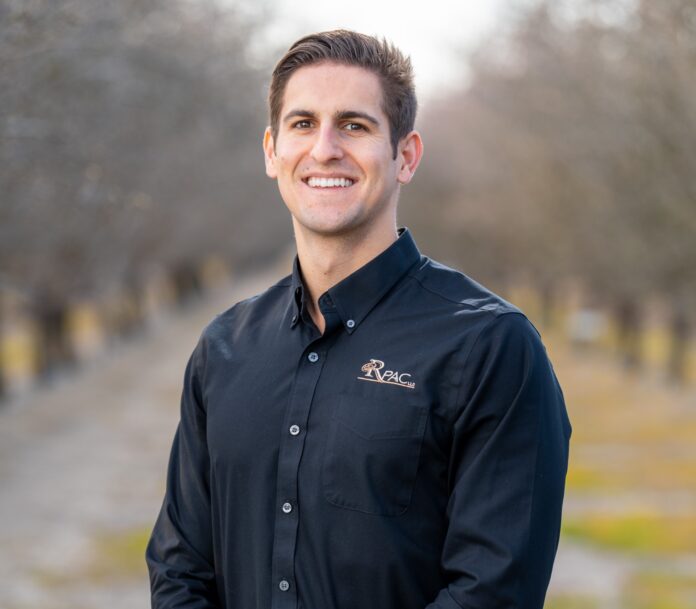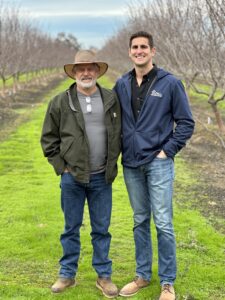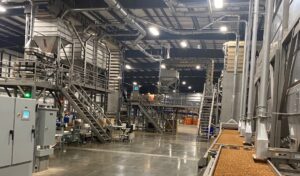
Mitch Moreda, in-shell marketing manager and grower representative for almond processor RPAC LLC, grew up in the almond orchards on his family farm. But when it came time to choose a career path, Moreda decided to work on the other side of the shell in marketing and processing.
While he still keeps a foot in the family farm, helping when needed, his main focus now is on getting the best price he can for the almonds growers entrust RPAC to sell. Moreda, in his Almond Leadership Presentation for the Almond Board of California, recently was a voice for growers shedding light on the disparity between retail prices and grower prices, which is large and only continues to grow, playing a role in making it difficult for almond growers to continue to turn a profit.
Moreda may not spend every day tending the orchards, but his roots as a grower and his current position on the marketing side of the industry give him a unique perspective. We asked him to share his thoughts on the current and future state of the almond industry with West Coast Nut.

Q. Tell us a little bit about your family history in farming and how you got into growing nuts.
Actually, the same year I was born, 1996, is when my parents first planted their almonds. So, growing up, that’s all I knew for a long time. We do all our own farming. It has been such a big part of my life from the beginning.
Both sides of my grandparents were actually dairymen. My family was the only one that planted almonds. So, generations of farmers, but just in different industries.
Q. What led your parents to get into the almond industry?
They wanted to do their own thing, and they saw the investment and opportunity. So, they took the risk back then. I think it was like 80 cents a pound back then, so it’s a lot different than what it is today. I know farming practices and much more have changed drastically and just continue to become better and better over time.
Q. How did you decide that this is what you wanted to do?
Growing up farming you tend to adopt the lifestyle and become passionate about it. Initially, it was to study plant science and to attain my PCA license as I did. From there, just meeting people and being more interested in other things within the realm of almonds and agriculture, I found myself after college gravitating toward the marketing side. So, I came from the background of a grower to now helping market almonds with RPAC and the Parreira family out of Los Banos. I’ve been in the trade and sales side of things for four years now.

Q. How is that different than being on the growing side and are you still involved on the growing side with your family?
I’m still involved, but much less now due to my career with RPAC. I’ll help out when I can, but I’m definitely not on the ground every day like I used to be.
What I do now is more buyer and grower relations and knowing what the market’s doing, market trends and price discovery. It’s less of just trying to figure out how to be a good farmer, producing and being out in the field. It’s more about being the best we can be from the beginning of the process to loading product onto a ship. Internationally, I handle our in-shell products, which mainly go into India and China. There is a lot of customer management involved. Making sure we do business with good people we trust and produce a high-quality product for them. It is in everyone’s interest to maintain a good business relationship going both ways.
Q. Having been on both sides of the industry, how do you think the almond industry has evolved?
I think growers are more in tune with what it takes to have high-quality, high-production and long-lived orchards. We now have better cultural practices, nutrient and irrigation management, and knowing what the trees need.

Q. What things keep you up at night about the almond industry?
Luckily, we do not have customer defaults often, but this is a well-known risk in the industry and definitely keeps me up at night. Defaults are probably the biggest fear of processors as they can issue extensive costs to the business, so we need to know we are working with people that want to uphold contracts and be true to their word even when times are rough in the market. That would be the biggest thing for processors because once you ship those almonds out and they’re on the other side of the world, it can be pretty difficult.
Other than having dreams of strip spraying and having a tree limb smacking me in the face jolting me awake, I think another thing that keeps me awake giving me and my team an internal drive is trying to do the best we can to keep our growers happy. That’s what we strive to do because it’s a competitive landscape and our competition is extensive and they’re doing their best as well. So, just to bring back good grower returns for our growers showing that we put in the work.
Q. What are you most hopeful about for the future as far as growing and moving almonds?
I think the next 5 to 10 years have a really good outlook for almonds. I think the price will get back to a stable and profitable level. Almonds are probably the most marketable nut in the world, and we produce them better than any other place in the world. I think it is a great industry, and it will bounce back, and I’m looking forward to those times.
Q. Talk a little bit about the water situation in California.
I’m not a water expert, but obviously, water is one of our biggest assets. We need it, and there’s a lot of politics involved in it. It is the biggest factor in how many almonds we can produce and how much some of these growers are paying for their water. Hopefully, that all turns out well, but I think it will always be an issue one way or another.
Q. What do you think needs to happen to put the almond industry in the best possible direction for the future?
We may have a surplus in supply, which is suppressing demand and the price, but if you look at it the other way, if we were able to reach better trade agreements internationally as we can see Australia has with China and India, for example, we could see a substantial increase in demand. If we got support on that end, that would open up the floodgates to bring more demand for fair prices, and that would help get rid of some of the supply and bring supply and demand back to stability.
Also, the dollar has been so strong for quite a while now, and eventually, if the dollar starts to weaken to something more normal, it could give international markets more buying power. That would be extremely beneficial because 80% of our almonds are exported.
Also, almonds coming out. It’s sad for growers that have to take them out, but it’s also healthy for the market just to bring that supply back down to make it profitable for the long term.
And the Almond Board just marketing and getting better with their strategy of where they’re marketing, where they’re spending their dollars to get their best return on investment. That’s just getting better and better, and I think we’ll hit markets that were untapped and have great potential to increase the demand and get things back to where they need to be.
Q. Talk to us a little bit from a marketing perspective about what the Almond Board is doing and how that helps.
They help fund a lot of research studies and promote almonds in different markets of the world, and they allocate money to different markets, and they figure out where would be the best return on investment. And right now, it seems like India is kind of the big talking point. India is amazing in how many almonds they can consume over there. And if you look at it in a per-pound basis, it’s far below what the U.S. consumes. So, if India were to spend a bit more money on almonds with their 1.4 billion people, their consumption rate could see a substantial increase.
Q. What do you think are the biggest assets of the almond industry?
Around 80% of the world’s almonds come from California. We have the best growing climate for almonds, and the almond itself is probably the most marketable nut because it can be produced into such a large variety of items from flour to snacking. They’re in everything. They’re in every aisle of the grocery store. They have a long shelf life, about two years, and it’s just a healthy nut. So, the nut has so many things going for it.
Q. What kind of advice would you give to other young people interested in getting into the almond industry?
Depends on what they want to do. Being a grower is a large, long-term investment, a lot of ups and downs. And depends on what part of the industry, just as a whole.
People are passionate about this industry, either farming or on the processing and marketing side. I feel like it’s an extremely small-knit community and just meeting people and being a team player for the almond industry as a whole. People respect that and people are really passionate about it, and you should respect that.
And just learn. Whether it’s farming or in marketing or processing, everyone is trying to adapt and become better, and that’s what’s fun about it. I believe your time would be wasted in life if you’re not improving and adapting and looking to take on the challenges ahead. I believe the challenges are going to become greater and greater, so instead of thinking of it as a big burden and being a cynic, maybe look at it as another feat to accomplish to become stronger.
Q. Talk a little bit about those changes you’ve seen in the past decade or so.
Irrigation efficiencies. Back in the day, they used to do larger irrigations less frequently, and now we do more frequent irrigations with less volume to “spoon feed” the trees. My family adopted drip irrigation from a solid set system, so we are better able to spoon feed and irrigate immediately after the almonds are shook and on the ground to mitigate stressing the trees.
And on the marketing side? Luckily, I’m with a team who has many years of experience. When things go wrong, they can go really wrong, which is why we are always on high alert to avoid any of the pitfalls learned throughout the many years. Knowing who and who not to do business with is crucial and takes experience. As a processor, we are known to be proactive on improvements and keep up with the new technologies to create a better product.
Q. On the farming side, low-dust harvesters and self-driving tractors are great innovations, but what are the recent innovations on the processing side?
Electronic sorting has made leaps and bounds within the last 10 years. We’re able to process to a high specification with electronic sorters. The technologies that keep coming out to be more efficient in sorting out almonds have been really great.
Q. Who would you say was the biggest influence or mentor for you coming into the industry?
Initially, it was Dirk Ulrich, who is an independent PCA/CCA and very well-known in the area. He’s extremely experienced and well-versed, especially with almonds. I appreciate his passion and attitude working with his growers. That’s how I initially got interested and went on my route to study plant science and ag business at Cal Poly and attained my PCA license.
After Cal Poly, it’d be Paul Ewing, who I work under now at RPAC. Paul has been in the processing and sales/marketing side for over 20 years, and I am extremely grateful for his mentorship and expertise.
Q. Looking toward the future, do you see anything technology-wise coming down the pike that’s going to make a difference either in the grower area or in processing?
Regarding farming, I think it’s exciting what GUSS has accomplished by having driverless spray rigs and continuing that route of automation because it seems extremely efficient to not have a body there operating. The liability of having someone working is not as efficient, and having more things like that is revolutionary.
For the processing side, we’re very efficient at this point, but we are always looking for improvements.
Q. What advice do you have for growers looking to process and market their nuts?
It’s always been a competitive landscape for processors but especially in today’s environment. I think growers are seeing the differences of who they’re shipping their nuts to in times like this where it’s much more difficult. I would just recommend growers to work with strong performers and those they can trust who have been consistent through ups and downs.















